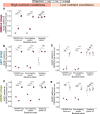Phage susceptibility to a minimal, modular synthetic CRISPR-Cas system in Pseudomonas aeruginosa is nutrient dependent
- PMID: 40904105
- PMCID: PMC12409346
- DOI: 10.1098/rstb.2024.0473
Phage susceptibility to a minimal, modular synthetic CRISPR-Cas system in Pseudomonas aeruginosa is nutrient dependent
Abstract
CRISPR-Cas systems can provide adaptive, heritable immunity to their prokaryotic hosts against invading genetic material such as phages. It is clear that the importance of acquiring CRISPR-Cas immunity to anti-phage defence varies across environments, but it is less clear if and how this varies across different phages. To explore this, we created a synthetic, modular version of the type I-F CRISPR-Cas system of Pseudomonas aeruginosa. We used this synthetic system to test CRISPR-Cas interference against a panel of 13 diverse phages using engineered phage-targeting spacers. We observed complete protection against eight of these phages, both lytic and lysogenic and with a range of infectivity profiles. However, for two phages, CRISPR-Cas interference was only partially protective in high-nutrient conditions, yet completely protective in low-nutrient conditions. This work demonstrates that nutrient conditions modulate the strength of CRISPR-Cas immunity and highlights the importance of environmental conditions when screening defence systems for their efficacy against various phages.This article is part of the discussion meeting issue 'The ecology and evolution of bacterial immune systems'.
Keywords: CRISPR-Cas; bacteria–phage interactions; microbial ecology and evolution.
Conflict of interest statement
We declare we have no competing interests.
Figures



Similar articles
-
Phage provoke growth delays and SOS response induction despite CRISPR-Cas protection.Philos Trans R Soc Lond B Biol Sci. 2025 Sep 4;380(1934):20240474. doi: 10.1098/rstb.2024.0474. Epub 2025 Sep 4. Philos Trans R Soc Lond B Biol Sci. 2025. PMID: 40904102 Free PMC article.
-
AcrIF11 is a potent CRISPR-specific ADP-ribosyltransferase encoded by phage and plasmid.mBio. 2025 Sep 10;16(9):e0169825. doi: 10.1128/mbio.01698-25. Epub 2025 Aug 14. mBio. 2025. PMID: 40810510 Free PMC article.
-
Directed evolution of bacteriophages: thwarted by prolific prophage.Appl Environ Microbiol. 2024 Nov 20;90(11):e0088424. doi: 10.1128/aem.00884-24. Epub 2024 Oct 30. Appl Environ Microbiol. 2024. PMID: 39475284 Free PMC article.
-
Armed Phages: A New Weapon in the Battle Against Antimicrobial Resistance.Viruses. 2025 Jun 27;17(7):911. doi: 10.3390/v17070911. Viruses. 2025. PMID: 40733529 Free PMC article. Review.
-
Phage engineering strategies to expand host range for controlling antibiotic-resistant pathogens.Microbiol Res. 2025 Nov;300:128278. doi: 10.1016/j.micres.2025.128278. Epub 2025 Jul 11. Microbiol Res. 2025. PMID: 40652883 Review.
Cited by
-
Preface: the ecology and evolution of bacterial immune systems.Philos Trans R Soc Lond B Biol Sci. 2025 Sep 4;380(1934):20240064. doi: 10.1098/rstb.2024.0064. Epub 2025 Sep 4. Philos Trans R Soc Lond B Biol Sci. 2025. PMID: 40904113 Free PMC article. No abstract available.
References
-
- Brockhurst MA, Koskella B, Zhang QG. 2021. Bacteria-phage antagonistic coevolution and the implications for phage therapy. In Bacteriophages (eds Harper DR, Abedon ST, Burrowes BH, McConville ML), pp. 231–251. Cham, Switzerland: Springer. ( 10.1007/978-3-319-41986-2_7) - DOI
MeSH terms
Grants and funding
LinkOut - more resources
Full Text Sources
Research Materials

